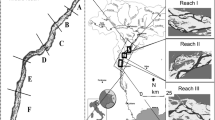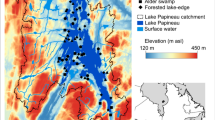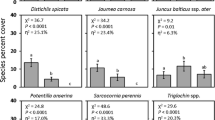Abstract
Flowing through Mongolia and Russia, the Selenga River is the main tributary to Lake Baikal, the world’s largest and deepest freshwater lake. The massive wetlands of the Selenga River Delta (SRD) on Lake Baikal perform important functions, including maintaining local and regional biodiversity and improving water quality. However, there exists a paucity of habitat and relevant ecological data for monitoring system-level changes. In this study, we characterized the rich habitat heterogeneity of the SRD using advanced 8-band multispectral satellite imagery coupled with a vegetation association algorithm and relatively extensive field surveys to analyze the spatial pattern of the system at multiple scales, from habitat-specific (e.g., Dense Floating Vascular habitats [Nymphoides sp.]) to coarser scales (e.g., Emergent Herbaceous; Aquatic Bed; Unconsolidated Bottom). We achieved an overall classification accuracy of 86.5 % for 22 wetland and aquatic habitat classes at the finest scale and greater than 91 % accuracy for broad vegetation and aquatic classes at more generalized scales. Our study provides the first detailed multi-scale characterization of the SRD for the conservation and management of the system and establishes baseline information for future change detection analyses.








Similar content being viewed by others
References
Adam E, Mutanga O, Rugege D (2010) Multispectral and hyperspectral remote sensing for identification and mapping of wetland vegetation: a review. Wetlands Ecol Manage 18(3):281–296
Arzandeh S, Wang J (2002) Texture evaluation of RADARSAT imagery for wetland mapping. Can J Remote Sens 28(5):653–666
Ball GH, Hall DJ (1965) ISODATA, a novel method of data analysis and pattern classification. DTIC Document
Beydeman IN (1981) Vegetation Ecology in the Selenga River Delta. 2nd edn. Nauka Publishing House, Novosibirsk
Bharati MH, Liu JJ, MacGregor JF (2004) Image texture analysis: methods and comparisons. Chemometr Intell Lab Syst 72(1):57–71
Chepinoga V (2012) Wetland vegetation database of Baikal Siberia (WETBS). Biodivers Ecol 4:311. doi:10.7809/b-e.00107
Cook BD, Bolstad PV, Næsset E, Anderson RS, Garrigues S, Morisette JT, Nickeson J, Davis KJ (2009) Using LiDAR and quickbird data to model plant production and quantify uncertainties associated with wetland detection and land cover generalizations. Remote Sens Environ 113(11):2366–2379
Cowardin LM (1979) Classification of wetlands and deepwater habitats of the United States. U.S. Fish and Wildlife Service, Washington D.C, FWS/OBS-79-31
Dechka J, Franklin S, Watmough M, Bennett R, Ingstrup D (2002) Classification of wetland habitat and vegetation communities using multi-temporal Ikonos imagery in southern Saskatchewan. Can J Remote Sens 28(5):679–685
DigitalGlobe (2010) The Benefits of the 8 Spectral Bands of WorldView-2 (White paper). http://www.digitalglobe.com
Dribault Y, Chokmani K, Bernier M (2012) Monitoring seasonal hydrological dynamics of minerotrophic peatlands using multi-date GeoEye-1 very high resolution imagery and object-based classification. Remote Sens 4(7):1887–1912
Dufrêne M, Legendre P (1997) Species assemblages and indicator species: the need for a flexible asymmetrical approach. Ecol Monogr 67(3):345–366
Emmerton CA, Lesack LF, Marsh P (2007) Lake abundance, potential water storage, and habitat distribution in the Mackenzie River Delta, western Canadian Arctic. Water Resour Res 43 (5)
Euliss NH, Gleason RA, Olness A, McDougal RL, Murkin HR, Robarts RD, Bourbonniere RA, Warner BG (2006) North American prairie wetlands are important nonforested land-based carbon storage sites. Sci Total Environ 361:179–188
Foody GM, Campbell N, Trodd N, Wood T (1992) Derivation and applications of probabilistic measures of class membership from the maximum-likelihood classification. Photogramm Eng Remote Sens 58(9):1335–1341
Foti R, del Jesus M, Rinaldo A, Rodriquez-Iturbe I (2012) Hydroperiod regime controls the organization of plant species in wetlands. Proc Natl Acad Sci 109(48):19596–19600
Franklin SE, Peddle DR (1990) Classification of SPOT HRV imagery and texture features. Remote Sens 11(3):551–556
Gyninova A, Korsunov V (2006) The soil cover of the Selenga delta area in the Baikal region. Eurasian Soil Sci 39(3):243–250
Hampton SE, Izmest E, Lyubov R, Moore MV, Katz SL, Dennis B, Silow EA (2008) Sixty years of environmental change in the world’s largest freshwater lake–Lake Baikal, Siberia. Glob Change Biol 14(8):1947–1958
Haralick RM, Shanmugam K, Dinstein IH (1973) Textural features for image classification. Syst Man Cybern IEEE Trans 3(6):610–621
Hodgson M, Jensen J, Mackey H Jr, Coulter M (1987) Remote sensing of wetland habitat: a wood stork example. Photogramm Eng Remote Sens 53(8):1075–1080
Hui Y, Rongqun Z, Xianwen L (2009) Classification of wetland from TM imageries based on decision tree. WSEAS Trans Info Sci Appl 6(7):1155–1164
Ilyicheva E (2008) Dynamics of the Selenga river network and delta structure. Geogr Nat Res 29(4):343–347
Jain AK, Dubes RC (1988) Algorithms for clustering data. Prentice-Hall Inc, Upper Saddle River
Jensen JR (2005) Introductory digital image processing: a remote sensing perspective, 3rd edn. Prentice Hall, Upper Saddle River
Kandus P, Malvárez AI (2004) Vegetation patterns and change analysis in the lower delta islands of the Paraná River (Argentina). Wetlands 24(3):620–632
Khazheeva Z, Tulokhonov A, Yao R, Hu W (2008) Seasonal and spatial distribution of heavy metals in the Selenga River Delta. J Geog Sci 18(3):319–327
Konovalova TI (2002) Mapping Geosystems in the Selenga River Delta. Mapp Sci Remote Sens 39(4):295–302
Korytny L, Il’icheva E, Pavlov M, Amosova IY (2012) Hydrologo-morphological approach to regionalization of the Selenga river basin. Geogr Nat Resour 33(3):212–217
Leibowitz SG (2003) Isolated wetlands and their functions: an ecological perspective. Wetlands 23(3):517–531
Materka A, Strzelecki M (1998) Texture analysis methods-a review. Technical University of Lodz, Institute of Electronics, COST B11 report, Brussels:9–11
McClain ME, Boyer EW, Dent LC, Gergel SE, Grimm NB, Groffman PM, Hart SC, Harvey JW, Johnston CA, Mayorga E, McDowell WH, Pinay G (2003) Biogeochemical hot spots and hot moments at the interface of terrestrial and aquatic ecosystems. Ecosystems 6:301–312
McCune B, Grace JB, Urban DL (2002) Analysis of ecological communities, vol 28. MjM software design, Gleneden Beach
Mitsch W, Gosselink J (2000) Wetlands, 3rd edn. John Wiley and Sons, New York
Moore MV, Hampton SE, Izmest’Eva LR, Silow EA, Peshkova EV, Pavlov BK (2009) Climate change and the world’s “Sacred Sea”-Lake Baikal, Siberia. Bioscience 59(5):405–417
Mueller MH, van der Valk AG (2002) The potential role of ducks in wetland seed dispersal. Wetlands 22(1):170–178
Narumalani S, Jensen JR, Burkhalter S, Althausen JD, Mackey H (1997) Aquatic macrophyte modeling using GIS and logistic multiple regression. Photogramm Eng Remote Sens 63(1):41–49
Ozesmi SL, Bauer ME (2002) Satellite remote sensing of wetlands. Wetlands Ecol Manage 10(5):381–402
Potemkina T (2004) Hydrological-Morphological Zoning of the Mouth Zone of the Selenga River. Water Resour 31(1):11–16
Ramsar Convention of Wetlands (2012) The Ramsar Convention Definition of “Wetland” and Classification System for Wetland Type. http://www.ramsar.org/cda/ramsar/display/main/main.jsp?zn=ramsar&cp=1-26-7621235_4000_0. Accessed 10 feb 2012
Ramsar Convention on Wetlands Factsheet (1997) Information Sheet on Ramsar Wetlands, http://www.wetlands.org/RSIS/_COP9Directory/Directory/ris/2RU018en.pdf. Accessed on 15 Sept 2012, vol 2012. vol September 15, 2012
Research Systems Inc. (2007) ENVI Version 4.4 User’s Guide. ITT Visual Information Solutions
Richards JA, Jia X (1999) Remote sensing digital image analysis, vol 3. Springer, New York
Rusinek OT, Ufimtsev GF, Fialkov VA (2011) Baikal: A Scientific Tour of Lake Baikal. (Translated to English by Kaplunenko Y M.) Geo Academic Publishing House, Novosibirsk
Stehman SV (1997) Selecting and interpreting measures of thematic classification accuracy. Remote Sens Environ 62(1):77–89
Story M, Congalton RG (1986) Accuracy assessment: a user’s perspective. Photogramm Eng Remote Sens 52(3):397–399
Timm BC, McGarigal K (2012) Fine-scale remotely-sensed cover mapping of coastal dune and salt marsh ecosystems at Cape Cod National Seashore using Random Forests. Remote Sens Environ 127:106–117
Tiner R (2009) Overview of the NWI Program, Status report for the National Wetlands Inventory Program: 2009
Trofimova IE (2002) Typification and mapping of climate patterns within Baikalian mountain-andhollow system. Geography and Natural Resources (in Russian) 2:53–61
Tucker CJ (1979) Red and photographic infrared linear combinations for monitoring vegetation. Remote Sens Environ 8(2):127–150
Tulochonov AK, Plusnin AM (2008) The Selenga River Delta-Natural Biofilter and Indicator of the Condition of Lake Baikal. Publishing House of the Siberian Branch of the Russian Academy of Sciences, Novosibirsk (in Russian)
United Nations Educational S, and Cultural Organization (UNESCO) (1997) Convention Concerning the Protection of the World Cultural and Natural Heritage. World Heritage Committee. Proceedings of the 20th 713 Session, Merida. 02–07 December 1996. WHC-96/CONF.201/21
Vostokova EA, Gunin PD (2005) The Ecosystems of Selenga basin. Nauka Publishing House, Moscow (in Russian)
Wilen B, Bates M (1995) The US fish and wildlife service’s national Wetlands inventory project. Plant Ecol 118(1):153–169
Yamagata Y, Yasuoka Y Classification of wetland vegetation by texture analysis methods using ERS-1 and JERS-1 images. In: Geoscience and Remote Sensing Symposium, 1993. IGARSS’93. Better Understanding of Earth Environment., International, 1993. IEEE, pp 1614–1616
Zak MR, Cabido M (2009) Spatial patterns of the Chaco vegetation of central Argentina: integration of remote sensing and phytosociology. Appl Veg Sci 5(2):213–226
Acknowledgments
The U.S. EPA Office of Research and Development partially funded and collaborated in the research described here under contract EP-D-06-096 to Dynamac Corporation. The research conducted was also partially funded by the U.S. Department of State, Biochemical Redirect Program with support from Eun Joo Yi and Patrick Russo of the International Science and Technology Center, Moscow, Russia. We appreciate the technical review and feedback provided by Ken Bailey, U.S. EPA, and the programmatic support of Doug Steele, U.S. EPA. Qiusheng Wu of the University of Cincinnati and the Dynamac Corporation provided technical assistance and support. We thank Alexey I. Trepeznikov of the Murzino settlement, Russia, for his hospitality, conviviality, and knowledge of the SRD. The views expressed in this article are those of the authors and do not necessarily reflect the views or policies of the U.S. EPA.
Author information
Authors and Affiliations
Corresponding author
Electronic supplementary material
Below is the link to the electronic supplementary material.
Rights and permissions
About this article
Cite this article
Lane, C.R., Anenkhonov, O., Liu, H. et al. Classification and inventory of freshwater wetlands and aquatic habitats in the Selenga River Delta of Lake Baikal, Russia, using high-resolution satellite imagery. Wetlands Ecol Manage 23, 195–214 (2015). https://doi.org/10.1007/s11273-014-9369-z
Received:
Accepted:
Published:
Issue Date:
DOI: https://doi.org/10.1007/s11273-014-9369-z




